LAND AND FOREST STEWARDSHIP PLAN
SPRING 2023





THE FORMATION of the Sustainability Working Group in May of 2019 formalized Hamilton’s commitment to sustainability and carbon neutrality, and resulted in the creation of the Land and Forest Stewardship subcommittee whose members below have authored and overseen the implementation of this plan.
BRIAN HANSEN
Director of Environmental Protection, Safety, and Sustainability
ANDREA TOWNSEND
Associate Professor of Biology
AARON STRONG
Assistant Professor of Environmental Studies
PETER GUIDEN
Assistant Professor of Biology
HEATHER KROPP
Assistant Professor of Environmental Studies
ANDREW JILLINGS
Director of Outdoor Leadership
MIKE JASPER
Facilities Management, Grounds and Fleet Manager
MARGARET PHIPPS ’23
ELLIE SANGREE ’24
EILEEN BUSSIERE ’24
Hamilton College recognizes our collective responsibility to acknowledge our colonial history. Our campus is located on the ancestral lands of the Oneida Nation. We express gratitude for the relationship between Chief Skenandoah and Samuel Kirkland, who founded the Hamilton-Oneida Academy to educate Indigenous and settler youth together. That institution became Hamilton College.

ORIGINALLY FOUNDED as the Hamilton-Oneida Academy, Hamilton College was officially chartered in 1812. Hamilton’s commitment to landscape preservation dates to 1850 when Oren and Nancy Root bought a building near the center of campus (named “The Homestead”) and set about planting trees, shrubs, and flowers in what eventually became known as the Root Glen. Today, Hamilton’s verdant, 1,390-acre campus is an admixture of managed campus facilities and landscapes, athletics fields, forested areas, and open lands, each of which serves our 200+ year academic mission.
In the past, certain contiguous and non-contiguous forested areas and open lands surrounding the Hamilton campus served purposes other than those directly related to environmental stewardship, including potential or actual revenue streams associated with timber harvesting and sale, or leasing to neighboring farmers for agricultural uses; acreage set aside for potential managed campus expansion; and recreation related to a nine-hole golf course and trails for walking, hiking, or biking. The non-contiguous forest was
originally a fenced/controlled area designed to protect three small reservoirs that provided the campus its drinking water.
Today, however, the emphasis of our land/forest management has shifted to better match Hamilton’s commitment to education and research, while continuing to provide low-impact recreation opportunities for our community. Hamilton’s forested areas and open/ agricultural lands also serve as a critical component of the College’s commitment to sustainability and carbon neutrality.
Specifically, our management goals are designed to meet the following guiding principles:
1. Promote academic teaching and research opportunities to enhance Hamilton’s educational mission.
2. Maximize carbon storage and sequestration, to the extent possible in consideration of our other goals, from our forests and open/agricultural lands (including the former golf course).
3. Protect and expand the health and diversity of native flora and fauna through reforestation, invasive species management, and appropriate silvicultural practices.
4. Facilitate low-impact recreation and wellness opportunities.
5. Promote biodiversity and native wildlife populations.
All future work in our open and forested lands will be made with careful consideration of research, biodiversity, and sustainability goals.
The 1,390-acres comprising Hamilton’s lands are generally divided into three use types:
THE 400-ACRE HAMILTON CAMPUS 1
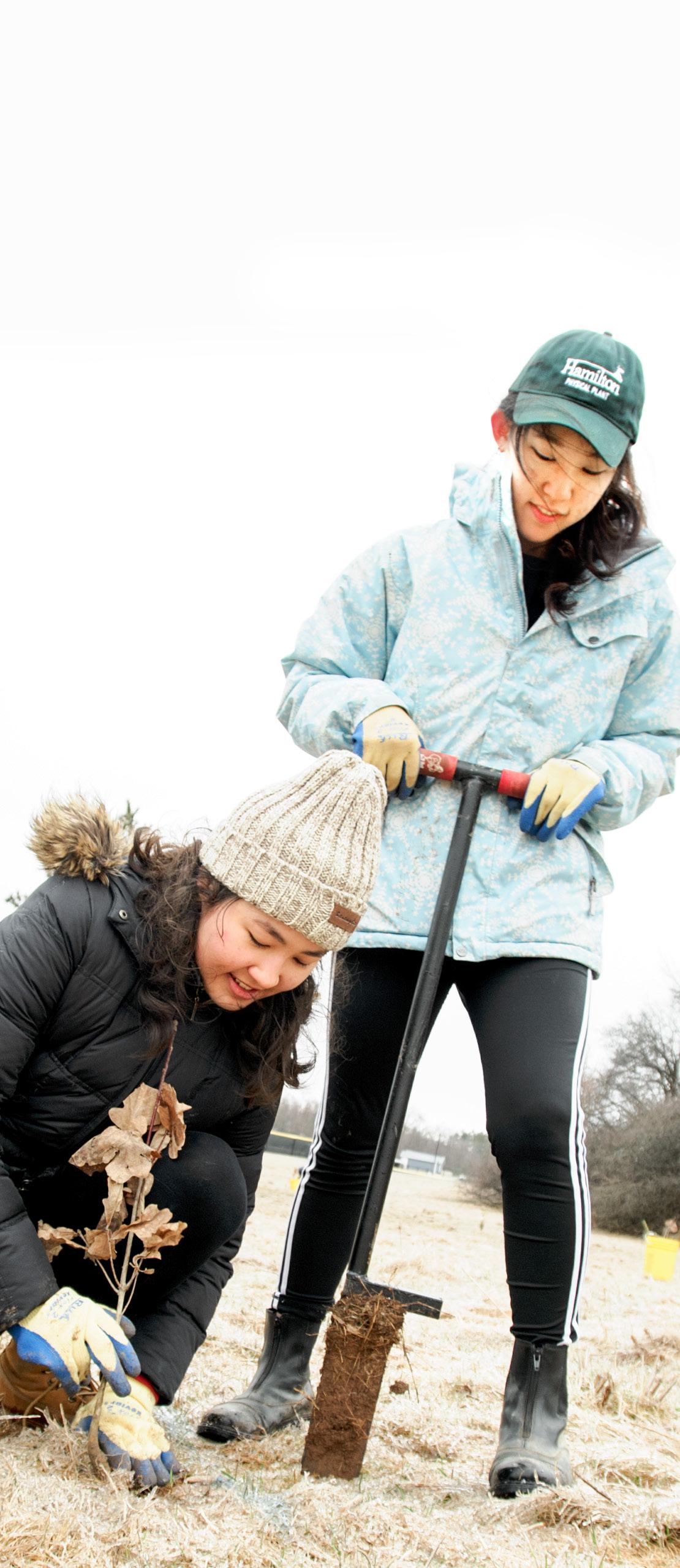
Inclusive of
• Buildings
• Facilities Management spaces
• Athletics fields
• Parking lots
THE FOUR DISTINCT FORESTS (total 800 acres) 2
• Kirkland Forest
• North Central Forest
• Reservoir Forest
• Rogers Forest
190 ACRES OF AGRICULTURAL LAND (current and former) 3
• Parts of the old golf course
Broadly speaking, the Hamilton College Landscape Master Plan has jurisdiction over the 400 acres comprising the campus, while this Land and Forest Stewardship Plan has jurisdiction over the 990 acres of forested and open/agricultural lands. Accordingly, the bulk of this plan will focus on the tactical management of those 990 acres; however, since the Landscape Master Plan implements sustainable landscaping elements into the Hamilton campus proper (low-mow/no-mow areas and pollinator habitats), those elements will be discussed in Section 5 (Green Attributes and the Main Hamilton Campus).
Hamilton’s open and agricultural lands generally include those that are currently or were formerly under agricultural lease contracts with neighboring farms and certain areas vacated by the former nine-hole golf course. The majority of the 14 tracts of open/agricultural lands are on either side of Campus Road, with one additional tract located off of Reservoir Road (Fig. 1).

Tract 1 12.27 acres
Tract 2 8.05 acres
Tract 3 18.05 acres
Tract 4 18.04 acres
Tract 5 20.54 acres
Tract 6 2.21 acres
Tract 7 11.37 acres
Tract 8a/b/c 12 acres
Tract 9 1.8 acres
Tract 10 1.6 acres
Tract 11 16.91 acres
Tract 12/13 30.1 acres
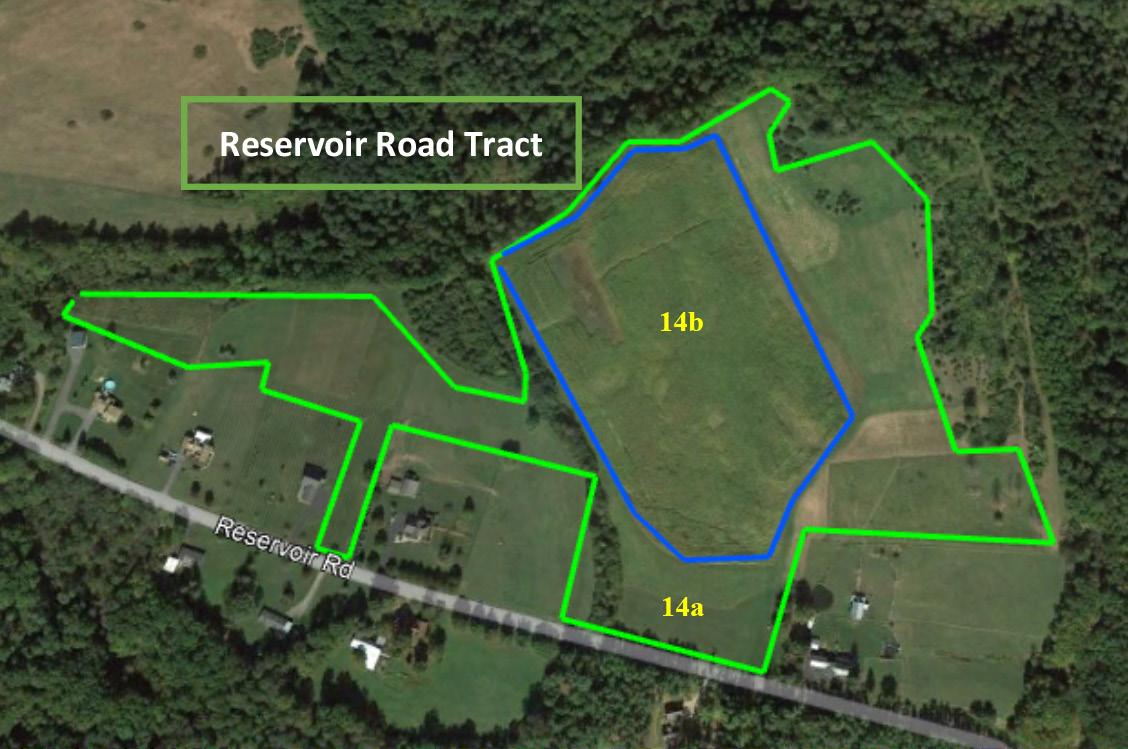
Tract 14a/b 35 acres
• 103.5 acres (blue) under current agricultural lease contracts
• 84.4 acres (light green) are former agricultural lands/golf course currently being managed through reforestation or managed grasslands
• Totals — 187.9 acres and 14 tracts
Hamilton’s forests (Fig. 2) are mostly on the contiguous fringes of the main campus to the north and south of College Hill Road. The Reservoir Forest is a non-contiguous tract west of campus off College Hill Road. Combined, all of Hamilton’s forested lands total 803.5 acres, with each forest further subdivided into individual management stands that are characteristically unique by geography, dominant tree species, density, age, and other factors.
Total acreage for four forests and 44 individual forest stands: 803.5
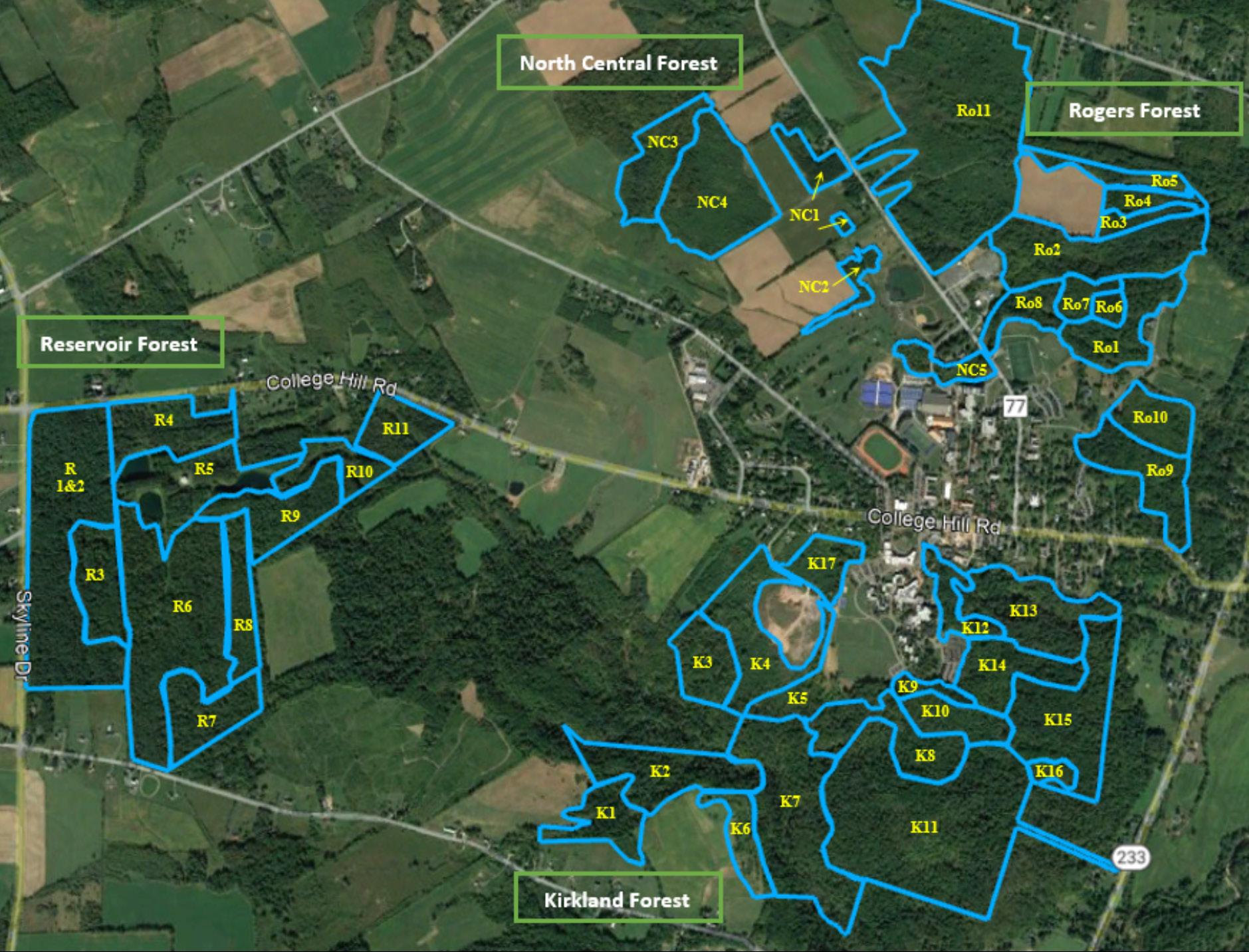
The goal of this plan is to actively manage the open and forested land in an intentional way that follows our guiding principles, with careful consideration of research, biodiversity, and sustainability goals. As of the writing of this plan, multiple projects are already underway and/or are in the near-term planning process. Examples of ongoing projects in portions of the former golf course (Tract 8) and an open area formerly used for agricultural purposes (Ttract 11) are described in Fig. 3. Below, we identify specific land/ forest management strategies, examples of ongoing projects, the research/educational and sustainability (carbon) impact of each strategy, and upcoming threeyear priorities.
• Area A is a 3.5-acre parcel near the former 7th and 8th holes that has been the focus of reforestation efforts since 2018 through the Sustainability Office. While it has only been marginally successful in terms of tree survival, it has been a feasibility demonstration to inform future reforestation decision making.
• Area B is a 2-acre parcel near the former 5th hole that Associate Professor of Biology Andrea Townsend has integrated into her fall Ecology classes since 2019. Over 200 trees protected by tree tubes have been planted with a very high survival rate. Future expansion of this area into Area C is planned.
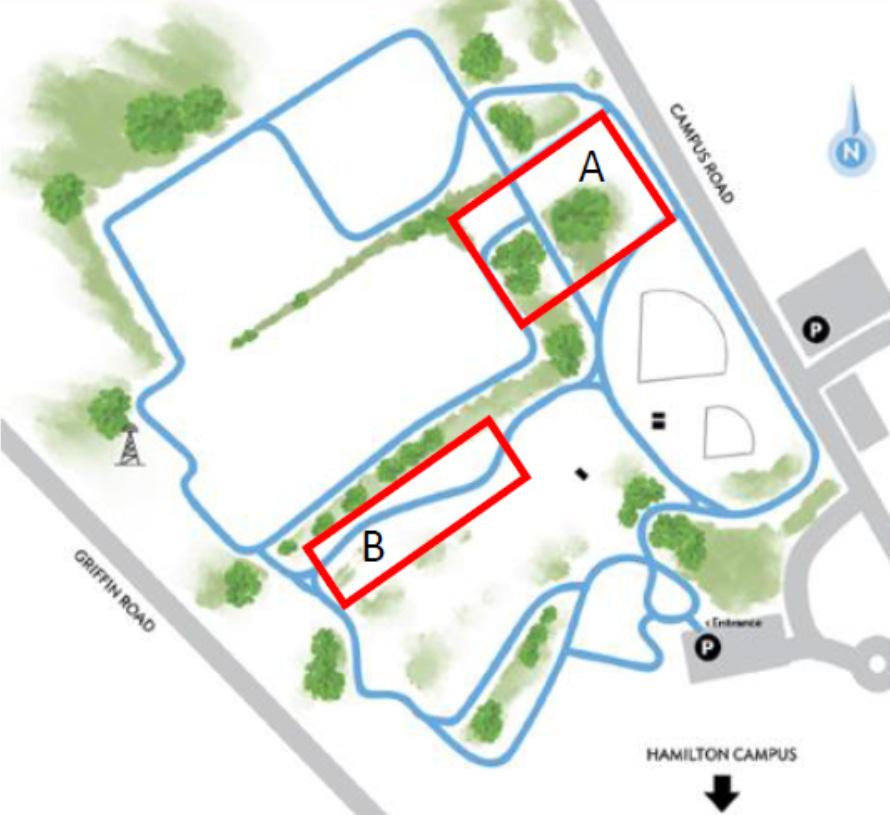
• In 2021, 8 acres of this 17-acre tract were enclosed with fencing to exclude deer, and 250 native trees were planted (mostly in tree tubes and mostly within the fenced area). Several hundred black walnut seeds were planted as well.

• In 2022, another 700 native trees were planted in this tract, all protected by tree tubes. 500 were planted outside the fencing, and 200 were planted within it. A portion of the unfenced area has been cleared and tilled for future seed distribution.

Although all land currently under agricultural lease contracts is under consideration for future reforestation efforts (Fig. 1), we have two primary short-term goals for existing forest, agricultural lands, and fallow fields on campus (Table A). First, we will reforest all lands previously held in agricultural leases on the northeast side of campus (Tract 5, 6, 11). These reforestation efforts will help meet our guiding principles to promote native biodiversity and wildlife populations as well as to increase carbon storage and sequestration. Second, we will manage the four open fallow fields/meadows (Tracts 9, 10, 12, 13) on the east side of Campus Road as intentional grasslands, using them as a teaching and research opportunity to assess grassland management techniques that maximize biodiversity and wildlife habitat. In addition to the specific management actions outlined in Table A, all efforts will include measures to mitigate and prevent the spread of invasive species. Timelines for short-term goals are outlined at right.
TABLE
Areas Goal Management Strategies
Tract 11 Reforestation
Tracts 5 & 6 Reforestation
Tracts 9 & 10
Managed Grassland and Shrublands
Golf Course Reforestation
Native trees planted in fenced enclosures and deer exclusion tubes. Success of different strategies monitored/compared.
Native trees will be planted in deer exclusion tubes by an external company.
Brush-hogging on a rotating schedule in the late fall (after nesting season) every three years to reduce shrub encroachment and maintain early-successional stage.
Native trees will be planted in deer exclusion tubes by students in classes and outreach events.
Completion Timeline
2021-23
2022-25
2022-
2019-
Ongoing and future research projects in Hamilton’s open and forested lands support faculty scholarship, student research, are experiential learning, as well as inform the College’s goals and responses to managing and conserving land. Ongoing projects include longterm monitoring of tree species diversity and carbon sequestration (Guiden, Strong, and Kropp), monitoring the water cycling and soil moisture in different land cover types (Kropp and Benson ’23), monitoring wildlife communities (small-mammal live-trapping, camera trapping; Guiden), quantifying herbivory and seed predation (Guiden), monitoring weather and the campus microclimate (Kropp), soil carbon measurements in different land use types (Strong), monitoring the success of different reforestation techniques (Townsend, Watkins ’21), measurements of carbon, nitrogen, and methane cycling in reservoir ponds and wetlands (Strong, Sangree ’24, Jacobs ’24, Hodges ’23), and assessment of avian biodiversity in different land use types on campus (e.g., golf course, old field, agricultural fields, regrowth forest (Townsend and Wydler ’21).
Currently, numerous Hamilton courses take advantage of forests and open lands to support hands-on learning in activities that are integral parts of the curriculum. These include introductory courses in Environmental Studies, Geosciences, and Biology, as well as ENVST 206 Introduction to Environmental Data, ENVST 212 Climate Change, BIO 237 Ecology, BIO 250 Biodiversity, BIO 419 Life and the Seasons, and others.
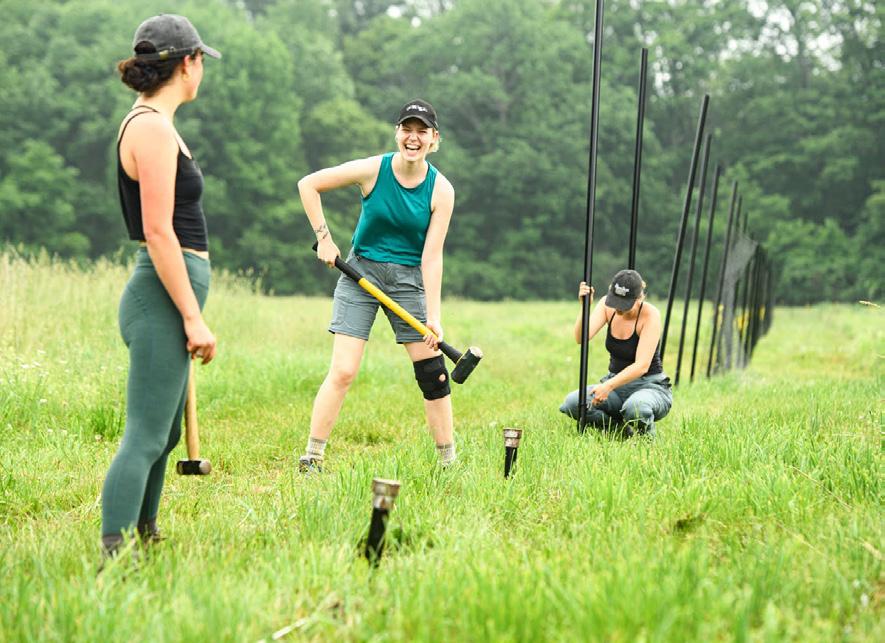
We recognize that forests are the products of decades of growth and development, and thus protecting existing forests is essential. Existing forests will be subject to increasing variability in weather and novel growing conditions as a result of climate change. The emergence of novel pests and worsening of forest infestations can impact developing and mature tracts. Therefore, management efforts will also prioritize the protection of existing forests from changing environmental conditions.
These forests represent an essential tool for teaching and research at Hamilton. All current and future land management decisions should keep Hamilton’s educational mission and our guiding principles at the
forefront. The health of the existing mature forest and meadows, and success of reforestation efforts, should be monitored in a research-driven framework to inform and evaluate management decisions. Management decisions should be adaptive, learning, and improving with experience, and consider the campus landscape as a whole, including the connections among individual tracts. Research, mapping, and data collection can facilitate this understanding of the broader campus landscape. Research efforts can offer longterm monitoring and add to assessment of Hamilton’s carbon and water footprint at the ecosystem scale. Land management practices should be documented and easily findable for research purposes. Data collected in coordination with land management practices should be made available for faculty to use in research and teaching. All strategies for management should consult the members of the Land and Forest Stewardship subcommittee, the Hamilton Experimental Forest Committee, and the natural resources supervisor.




Hamilton has intentionally integrated many environmental features into the main campus over its 200+ years, including major initiatives like the Root Glen and Arboretum, to smaller/building-specific elements like retention ponds and parking lot rain gardens. A 2019 Facilities Management initiative to stipulate landscape maintenance priorities (Fig. 4) was followed by an update to Hamilton’s Landscape Master Plan in 2020, which together set aspirations to better connect the historic environmental features on campus with those in Hamilton’s forests and open/agricultural lands under the banner of sustainability. Concurrently, it was vital to integrate academic teaching and research opportunities into the process.
• In 2019, Facilities Management developed this map to identify campus maintenance priorities. The sections shaded in purple were described as “naturalized areas,” but no formal process was developed to plan for and manage those areas into the future.

The Green Attributes Project may more correctly be described as one to define, delineate, and implement naturalized landscaping features on campus, such that they can be better managed in both the near and long term. The project began formally in the spring of 2022 by students and the Sustainability Office working with critical stakeholder groups, including several Biology and Environmental Studies faculty members and the departments of Facilities Management, Admission, Athletics, and Outdoor Leadership. The six-step process the students followed, including the land survey template they completed at 108 individual tracts of land, are depicted at right (Fig. 5).
By the end of the summer of 2022, the students/ Sustainability Office completed all six of the initial project steps identified above, and the Green Attributes Project is now moving into full implementation. Fig. 6 at right represents two of the critical project deliverables:
• New tract-by-tract definitions and maintenance regimes to replace the initial 2019 landscape maintenance priorities map.
• An interactive GIS map depicting our current tract management strategy that can be updated should a tract management change be necessary.

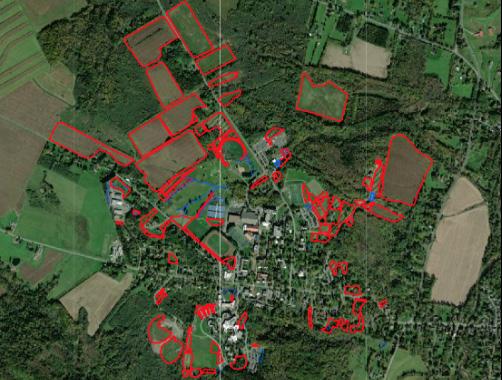


As depicted in Fig. 7, Hamilton has implemented two pollinator habitats on campus. In addition to eliminating resource-intense lawn mowing in these fields, the purpose of these habitats is to support and maintain pollinators (bees, butterflies, etc.) by supplying food in the form of pollen and nectar to bolster biodiversity and assure these important animals may pollinate nearby crops for continued fruit/vegetable production.
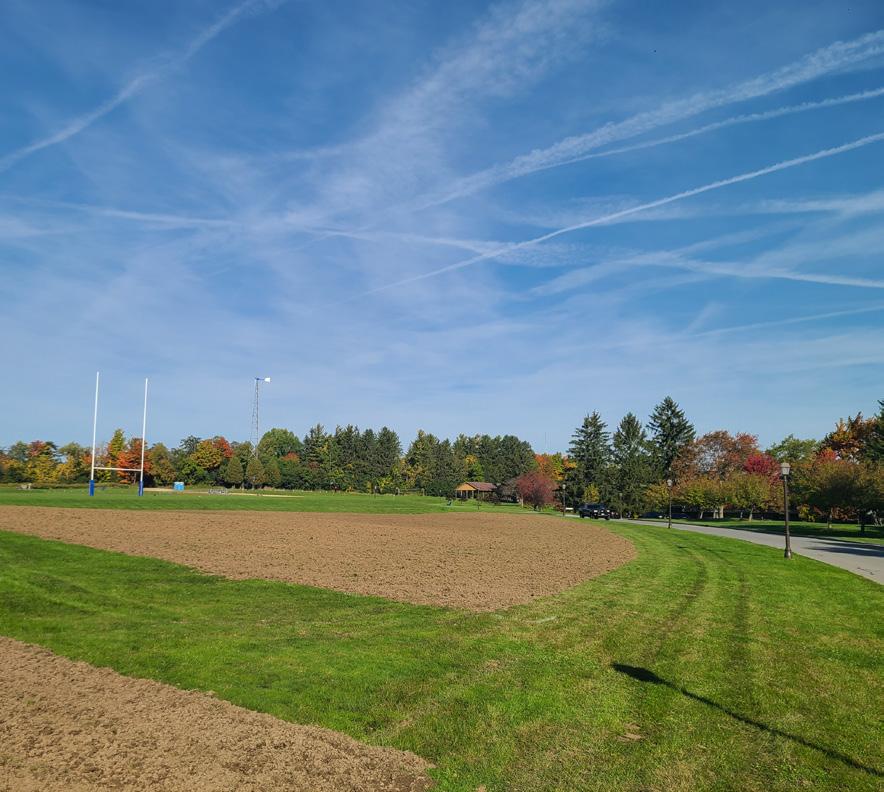
When the Green Attributes Project was in its initial conception phase (2021), students in the Sustainability Office, in collaboration with Facilities Management, designed a signage strategy to communicate land management tactics alternative to mowing in six locations on campus (Fig 8). Within the next year, this signage strategy will be dramatically and collaboratively expanded to highlight the fully implemented Green Attributes Project to former, current, and prospective members of the College community.



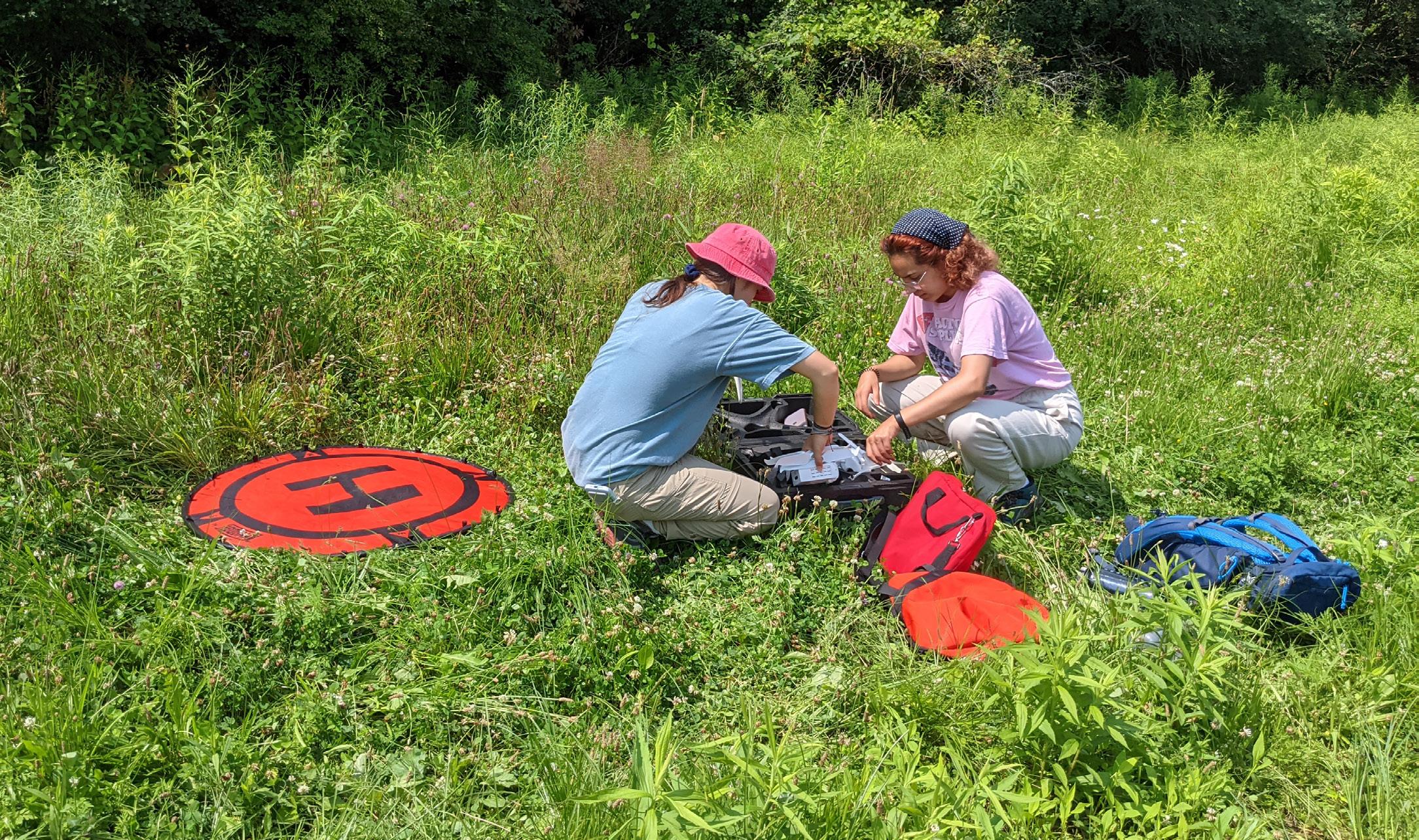

Hamilton’s Outdoor Leadership and Wellness programs are long-established and provide many benefits to the College community beyond sustainability. However, this plan’s guiding principles create a strategic intersection among these areas in our open/ agricultural lands and forests. All current and future expansion of trails will include plans to monitor and control invasive species, which can be spread by creating openings in existing forests. The following are ongoing projects and future areas of opportunity.
Since 2020, multiple tree-thinning and reforestation projects have resulted in the expansion of existing trail networks or created new trails (Fig. 9).
• Tree removal in 2020 and 2021 to increase emergency accessibility of water utility lines; the resulting trails were mulched and seeded in 2022 to expand the trial network in these areas.


• Reforestation efforts in 2021 and 2022 at Tract 11 created a new trail network around and through the tract.
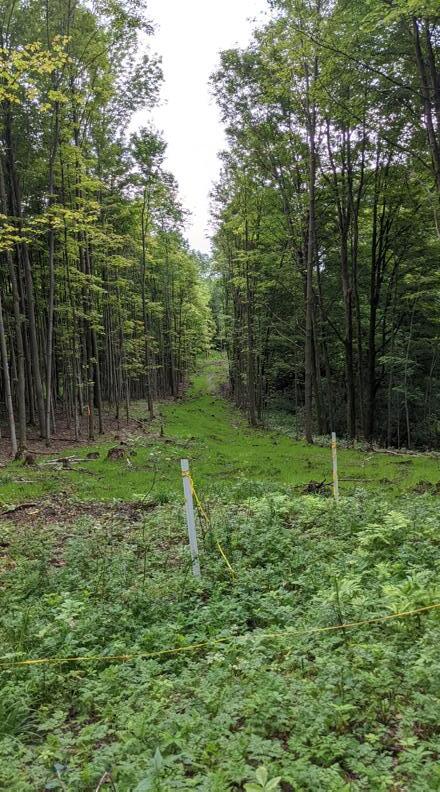
Outdoor Leadership has successfully implemented and managed trail systems in certain sections of the Kirkland and Rogers forests for many years. Fig. 10A/B depicts projects where students and the Sustainability Office have assisted (or will in the near future) Outdoor Leadership with the trail identification and signage program.
• Sustainability interns installing trail markers and developing maps in 2017.


Other areas of future intersecting opportunities between Outdoor Leadership/Wellness and sustainability in open/agricultural and forested lands include:
• Golf course replanting for snow management
• Campsite(s) establishment in the Kirkland forest, including building a bridge and new trail spur up the south side of Potter’s Trail
• Examine feasibility of recreation development in the Reservoir Forest with careful consideration of research, biodiversity, and sustainability goals
• Formal creation of a trail crew
• Trailhead wayfinding signage developed and installed in 2020 by Outdoor Leadership.

• Similar trailhead wayfinding signage will be developed and installed at the Reservoir Forest in the near future.
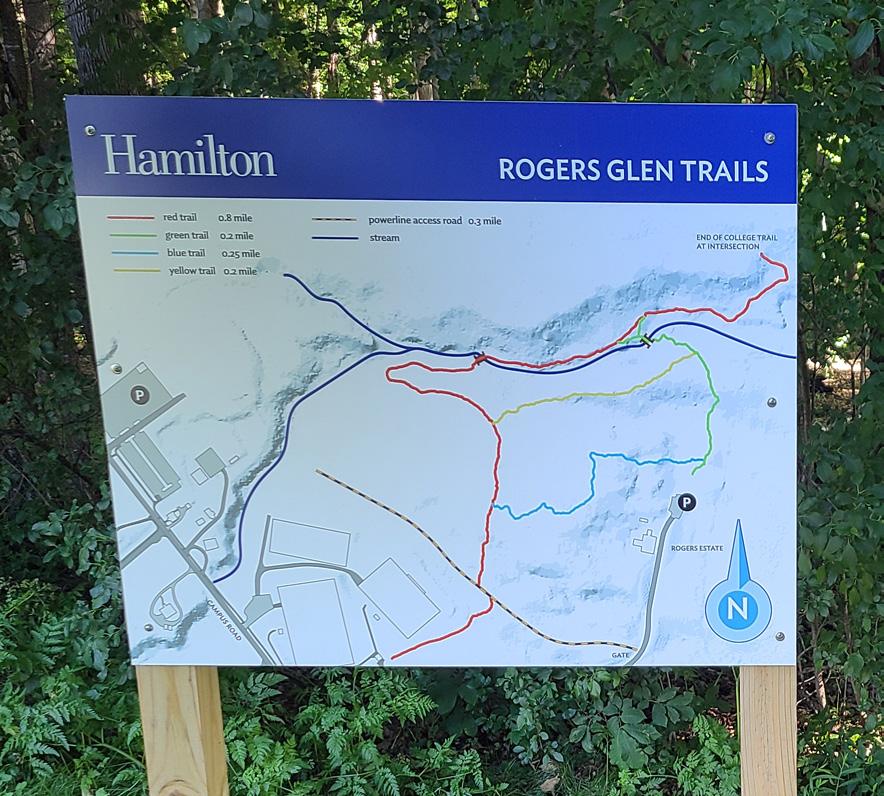


HAMILTON’S HALF-ACRE COMMUNITY
GARDEN (Fig. 11) was founded as the Hamilton College Community Farm in 2007 and is located to the northeast of the Woollcott and Ferguson houses. The original intent was for the farm to be a multi-plot food production operation for student workers and Hamilton’s primary food service provider, with one plot (the 1812 Heritage Garden) dedicated to an academic course titled Food for Thought; The Science, Culture, and Politics of Food.
Today (Fig. 12), most of the plots are managed by individual students or employees for their own enjoyment, and the 1812 Heritage Garden has been turned into a small apple orchard. Further, a small beekeeping operation is being piloted near the garden. While a formal, long-term plan for the Community Garden has yet to be established, currently there are two locations (marked “open plot”) that may be utilized by students, faculty, or staff. Discussions regarding increased utilization and potential expansion of the operation in support of our guiding principles are under active consideration.
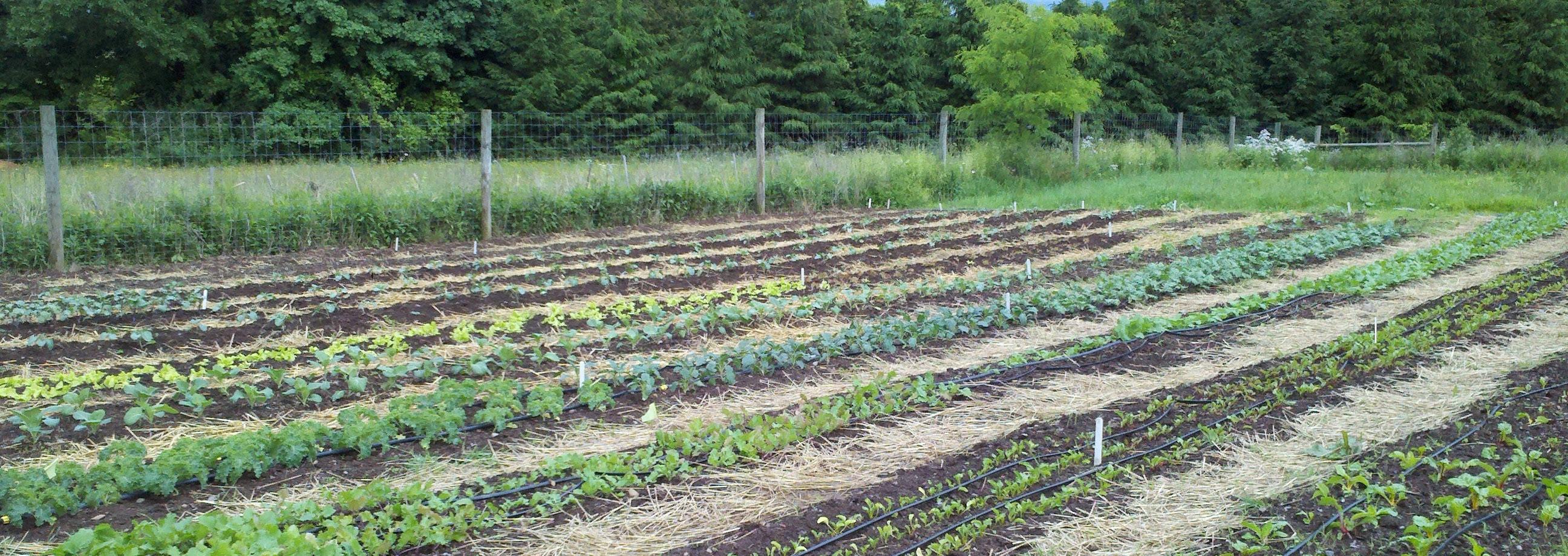
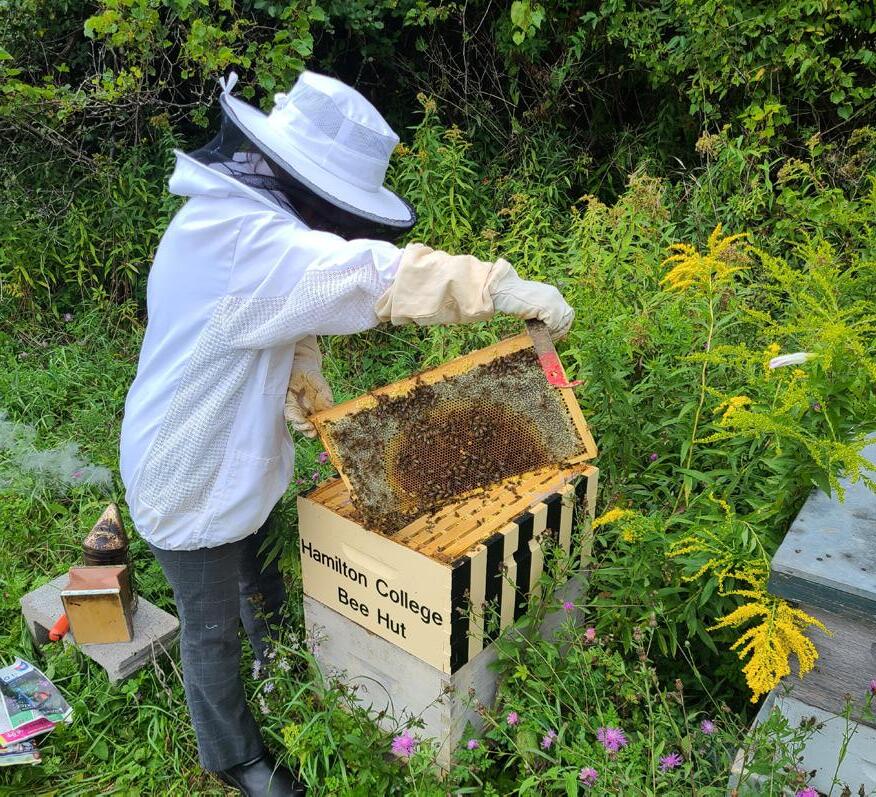
The ability for Hamilton to annually claim the carbon sequestered by its forested and open/agricultural lands as a sink in comparison to its carbon emissions inventory is based on several critical factors at the heart of this Land and Forest Stewardship Plan:

• Accurate forest/land measurement and forest-carbon accounting
• Formal certification and objective third-party verification
• Meeting the principle of additionality
The following pages discuss each of these factors.
Building upon an initial 1983 Timber Management Plan, Hamilton hired a consulting forester in both 2017 and 2020 to perform accurate forest-carbon accounting measurements to determine the applicable baseline sequestration rates (Fig. 13) of our four forests, in accordance with recognized and peer-reviewed techniques. Simultaneous and integral to that carbon-accounting process were the compilation of additional forest-by-forest and stand-by-stand criteria (i.e., stand acreage, age, species diversity/density, overall health, invasive species), which enable future management considerations focusing on criteria other than carbon.
INDIVIDUAL FOREST AND FOREST STAND SAMPLING LOCATIONS

• 2017—Reservoir and Kirkland forests baseline measurements
• 2020—Rogers and North Central forests baseline measurements
• 2022—5-year remeasurements for the Reservoir and Kirkland forests, and 2-year remeasurements for the Rogers and North Central forests
As a result of the determined feasibility of forest carbon sequestration to significantly contribute to our multi-pronged carbon neutrality strategy, Hamilton brought the forester back for remeasurement purposes in 2022 and will continue to do so at five-year intervals. It is important to note that if intentional silvicultural practices are performed to thin or remove individual trees/tree stands in a measurement tract or accidental (forest fires) or unplanned (theft) events occur beyond natural mortality, Hamilton will account for such events as generated emissions in its annual carbon emissions inventory.
A fundamental element of the formal forest certification process includes a third-party inspection across eight standard categories, including:

1. Commitment to practicing sustainable forestry (including a management plan)
2. Compliance with laws
3. Reforestation and afforestation
4. Air, water, and soil protection
5. Fish, wildlife, biodiversity, and forest health
6. Forest aesthetics
7. Protect special sites
8. Forest product harvests and other activities
From a forestry and geographical perspective, Hamilton’s four forests are only considered to be two distinct ones; those that are contiguous to the campus proper (Kirkland Forest, North Central Forest, Rogers Forest) and those that are non-contiguous to the campus proper (Reservoir Forest). Both forested areas were formally certified through the American Tree Farm System (ATFS) following inspection and verification by Steven Bick (a qualified ATFS inspector) on Feb. 6, 2020, with the following ATFS designations:
• Non-contiguous forest (Reservoir): Tree Farm Number 4222
• Contiguous forest (Kirkland, North Central, Rogers): Tree Farm Number 4223
All future management actions embodied by this Land and Forest Stewardship Plan shall both observe our established guiding principles and conform to the minimum forest certification standards necessary to maintain such certification.

By managing existing forested lands to sequester carbon, Hamilton can reduce its net greenhouse gas emissions. However, Hamilton must consider the additionality of these carbon removals (i.e., Are we removing more carbon from the atmosphere than would have occurred without Hamilton’s actions?). The aforementioned 1983 Timber Management Plan evaluated Hamilton’s forests for their financial value if they were to be harvested and sold as home-heating cordwood or saw-timber for construction/furniture manufacturing. Today, Hamilton values its forests and open/agricultural lands for both their intrinsic natural value as well as their capacity to sequester carbon in pursuit of carbon neutrality goals.
If not for its historic and future intended forest/ land management efforts, it is likely that at least 90% of Hamilton’s existing forested landholdings (those areas outside of glens or deep ravines) would have been cleared for agricultural purposes, like most of
the surrounding area (Fig. 14). Thus, we are electing to account for 90% of the carbon sequestration — the carbon removed each year from the atmosphere from forest growth — as additional and as negative emissions in our inventory. This approach to carbon accounting is in line with the requirements of carbon inventory reporting to Second Nature.
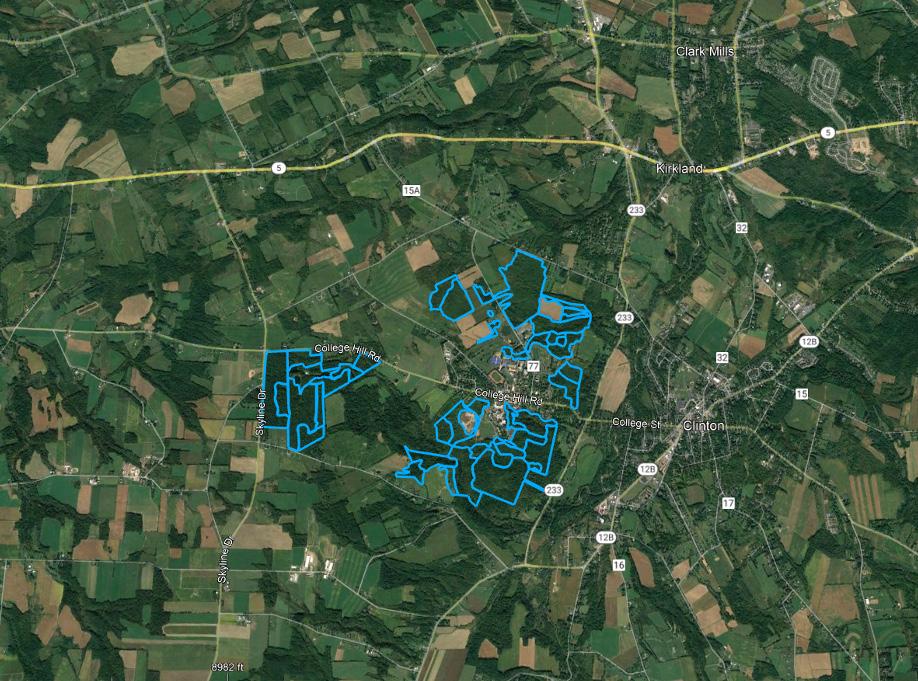
Hamilton further postulates that this Land and Forest Stewardship Plan, in active pursuit of its established guiding principles, is additional and beyond the “business-as-usual” standard such that
• 90% of the forest carbon sequestered annually (minus any intentional, accidental, or unplanned events) as remeasured every five years and
• 100% of the carbon sequestered from the reforestation tracts Hamilton has or intends to implement in the near future (to be assessed once there is measurable (>3”) tree growth and therefore carbon)
will be treated as a carbon sink and deducted from our annual carbon emissions inventory in pursuit of our carbon neutrality strategy.

JAY CARHART ’21
DON CROFT
Former Natural Resources Manager
EMMY GOODWIN ’23
BILL PFITSCH
Associate Professor of Biology Emeritus
SARAH STIGBERG ’20